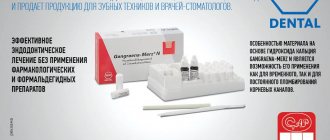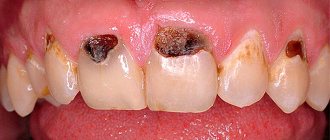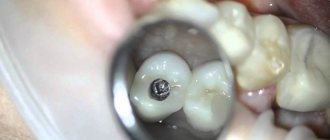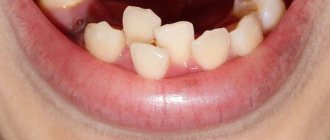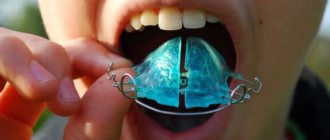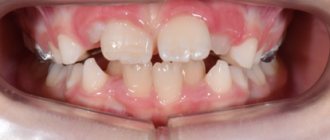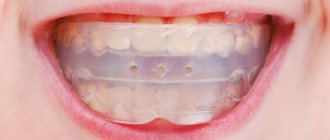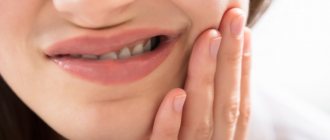Open bite is a pathological condition of the bite in which a significant gap or gap remains between the upper and lower teeth. This space is maintained even when the jaws are tightly closed. Often the anomaly is accompanied by the fact that the lips also do not close, that is, the mouth practically remains open.
This pathology does not occur often, but you need to understand that it entails improper distribution of the load on the elements of the dentition and jaw bones and affects the functioning of the entire digestive system. Dentists are unanimous: the only correct solution is early treatment of an open bite.
Consequences
Open bite is a problem that affects not only a person’s dental health. It does not return to normal on its own, so delaying contacting a specialist is fraught with the following problems:
- violation of diction;
- difficulty breathing through the nose;
- difficulty chewing food and, as a result, digestive problems;
- distortion of normal facial proportions;
- hypertonicity of facial muscles.
Possible complications
Open vertical occlusion does not remain without consequences. The aesthetics of the face and smile suffer, difficulties develop in other functional departments:
- Digestion is disrupted due to problems with biting and chewing;
- the person has a lisp, and with a large gap, speech is slurred;
- The TMJ (temporomandibular joint) experiences difficulties, muscle tone decreases;
- the condition of the periodontium worsens (it experiences excessive load);
- the abrasion of the enamel of the teeth, on which all the work “falls”, increases, they are more loaded and experience increased pressure;
- Mouth breathing develops problems with the ENT organs and respiratory system.
Causes
The causes of this pathology are varied. They can be congenital or acquired.
Among the reasons why a child appears with the makings of an anomaly of this type are:
- genetic factors;
- certain diseases of the mother during pregnancy;
- toxicosis of pregnant women;
- parents living in unfavorable environmental conditions;
- incorrect formation of germinal leaves due to random mutations;
- taking certain medications or narcotic drugs at any stage of pregnancy or before it.
The reasons that lead to the appearance of this pathology after birth:
- progressive rickets;
- disturbance of mineral metabolism;
- hypovitaminosis;
- dysfunction of the endocrine system;
- any conditions leading to impaired breathing through the nose (polyps, deviated nasal septum, allergies, etc.);
- bad habits, especially in childhood (finger sucking, tongue sticking out between teeth, etc.)
There are also dental reasons:
- late eruption of the milk supply;
- edentulism;
- loss of teeth due to injury or illness;
- short lingual frenulum;
- enlarged tongue.
The anomaly can develop due to neurological disorders that force the child to constantly suck his fingers or periodically stick his tongue into the tooth gap. Then treatment should extend not only to the dental, but also to the neurological sphere.
Thumb sucking is often the cause of an open bite.
Why does malocclusion form?
Pathology can develop at any stage of a person’s growing up: during the periods of formation of the deciduous, mixed, and permanent dentition. It is formed for various reasons. For example, a false bite is most often formed due to harmful habits (thumb sucking, tongue protrusion, lip biting, etc.). The formation of pathology can be provoked by a short frenulum of the tongue, an irregularly shaped pacifier, or the absence of one or more front teeth.
Another reason is the habit of breathing through your mouth. If there are problems with nasal breathing due to rhinitis, enlarged adenoids, chronic sinusitis, polyps, or a deviated nasal septum, the child breathes through the mouth. This habit affects swallowing function and provokes the development of an open bite.
A true bite develops slowly and is characterized by abnormal development of the jaw bones. The abnormal structure is most often associated with infantile rickets.
Other reasons:
- metabolic imbalance;
- genetic predisposition;
- macroglossia (abnormally large tongue size);
- lack of vitamins in the body;
- various injuries;
- late or too early teething;
- somatic, infectious diseases of the mother suffered during pregnancy.
Regardless of the causes of formation and type of pathology, the defect can be eliminated. The anomaly is difficult to correct, but in modern orthodontics there are many ways to change the geometry of the bite. The main thing is not to refuse treatment and start it in a timely manner.
Kinds
Experts identify several types of this anomaly.
The first classification concerns the origin of open bite:
- true - the one that appeared due to the defective condition of one or two jaws;
- false – caused by injuries or bad habits.
By location of the cleft:
- frontal – the gap is located in the front;
- lateral – a gap on the side.
Lateral can be one-sided or two-sided, when there is a gap on both the right and left.
By severity:
- first degree – gap up to 5 mm;
- second degree – gap 5-9 mm;
- third degree - a gap longer than 9 mm.
Diagnostics
In addition to a visual examination, the orthodontist can measure the gap and assess the degree of open bite for further treatment. There is a possibility of direction for more in-depth research that will give a complete picture:
- teleroentgenogram;
- orthopantomogram;
- taking impressions.
Often a specialist sees the presence of a combination of disocclusions: distal open bite, mesial.
To collect information about the patient and the progress of the correction, before and after photos are taken.
Signs
The presence of an open bite can be judged by several signs. Some of them can only be identified by orthodontists, but most are noticeable even to a non-specialist:
- elongated lower part of the face;
- slightly open mouth;
- invisible chin fold;
- shortened upper lip;
- the edges of the front incisors are constantly visible;
- lips pursed with force;
- crowding of the anterior incisors.
In childhood, all these signs lead to caries on the front teeth, the cutting edge becomes uneven, and plaque is noticeable on the enamel. Often all this is accompanied by bleeding gums and gingivitis. Due to the fact that breathing is done through the mouth, the mucous membrane inside the oral cavity often dries out.
Classification and stages of development of open bite
Open bite is distinguished depending on its location. In this case, front and side options are distinguished. There are also types of open bite based on jaw location. These are combined options that affect both jaws, as well as the maxillary and mandibular.
Traditionally in dentistry, there are three stages of development of such a defect as an open bite, which differ in the degree of its severity:
- At the first stage, the gap between the teeth does not exceed 5 mm.
- At the second stage, it can range from 5 to 9 mm.
- The third stage is characterized by a gap larger than 9 mm.
Depending on the stage of the disease, the doctor will select the most effective treatment method.
Treatment
Orthodontists note that the earlier treatment is started, the faster complete recovery will occur. Early initiation of correction reduces the severity of the consequences, and in many cases prevents the onset of accompanying disorders.
Among the main methods are the following:
- Muscle myogymnastics . This method brings excellent results at the stage of formed primary occlusion, and in older patients it can be used in complex therapy. The child should already be able to understand what they want from him and what movements need to be performed. Such exercises are performed with special devices (Rogers shock absorber, Dass activator, etc.) or without them. Myogymnastics has almost no contraindications or side effects, does not cause harm to the body, therefore it is considered one of the safest and most accessible methods, since it does not require costs.
- Functional devices . The Klammt activator, Herbst apparatus, expanding action plates, etc. are aimed at equalizing the balance in the dental system. Compensatory mechanisms in the child’s body make it possible to gradually get rid of an open bite while constantly wearing these devices.
- Chin sling . An overhead bandage that is fixed to the temporomandibular joint. Dressing every day while you sleep stops the movement of the lower jaw.
- Removable mouthguards . Prescribed after the formation of permanent dentition. The wearing time is determined by a specialist, but in any case it will last for a much longer period than the treatment of an open bite in childhood.
- Engle's apparatus and Cojocaru's apparatus . Arches with hooks are placed on the teeth, which stretch the jaw with tension.
- Prosthetics. To get rid of the gap, crowns are installed, which help normalize the bite.
- Bite blocks . Made individually for each patient. They reduce the height of the jaw on the sides and improve the patient's appearance.
- Braces . They are used at the time of the replacement bite, until the formation of the skull bones is completed. After the end of growth (after puberty), braces can only change the direction of the teeth, but this method will no longer have an effect on the jawbone.
- Surgical method . It is most often used for adults who were not treated properly as children or who suffered from a problem due to injury. The operation is performed under general anesthesia in the Department of Maxillofacial Surgery.
If serious diction disorders are observed with an open bite, then treatment should be accompanied by speech correction under the guidance of a speech therapist.
How is an open bite treated in children?
It is better to correct open type disocclusion during the period of bite formation. The choice of correction method depends on the nature of the identified anomaly and the age of the child. In primary occlusion, pathology is rare, and treatment is preventive.
✔
Eliminate habits that cause crooked teeth.
✔
From birth, teach your baby to breathe through the nose.
✔
If necessary, shorten the hyoid frenulum.
✔
Check your body regularly for rickets.
Oral hygiene and timely replacement of lost teeth, including milk teeth, are of great importance in the prevention and treatment of open bite.
To normalize the bite, children are prescribed physiotherapeutic procedures and individually selected myogymnastic exercises, but this is not enough to treat complex forms of pathological bite. After 4 years, orthodontic structures help normalize occlusion and eliminate functional and aesthetic deviations in children.
- The palatal expander
allows you to eliminate abnormal curvature formed due to a mismatch in the size of the jaws. - Orthodontic devices
- corrective intermaxillary traction and a chin sling that controls the development of the lower jaw correct a jaw that protrudes too forward. - Plastic bite plates (bases) and removable activators
stabilize muscle function and restore the correct position of the tongue.
At the age of 12-13 years, when permanent teeth have already formed, to eliminate open-type disocclusion, children are fitted with permanent braces and mouth guards to straighten teeth.
Prevention
Prevention of open bite is extremely important not only for its initial prevention, but also after correction, so that the pathology does not return.
The main preventive measures are:
- control over the eruption of primary and permanent teeth;
- timely treatment of carious lesions;
- prosthetics in the absence of elements of the dentition;
- unlearning bad habits;
- correct head position during sleep;
- timely treatment of ENT organs to ensure normal nasal breathing;
- presence of solid foods in the diet;
- learning the correct pronunciation of sounds.
How to eliminate an open bite in adults
In adults, correction takes longer and is more difficult. It is recommended to wear mouth guards to straighten the teeth, use braces, and install crowns to change the height of the bite. These correction methods are effective, but do not always help. In complex cases, surgical intervention cannot be avoided.
The goal of orthognathic surgery is to return the jaw to its natural position. This is the fastest way to correct open disocclusion. The result will be noticeable immediately, but rehabilitation after surgery may take several months.
Appliances for correcting open bite
The choice of design depends on the complexity of the bite pathology itself, as well as on the individual characteristics of the patient. In addition, the price of such a device is important, because not everyone can afford expensive options. However, often more budget options turn out to be very effective in treating malocclusion.
Records
The plate is the simplest and most affordable design option for correcting an open bite. It can be prescribed to both adults and children. This device is a plate that consists of two parts fastened with a special screw. Both parts are attached to the teeth depending on the location of the bite deformation. After this, the doctor tightens the screw so that the pressure exerted by the plate on the teeth changes their position in the desired direction.
Trainers
Trainers are special silicone mouthguards for correcting open bites. They are made individually from a pre-made impression. They can be worn both during the day and at night.
Bracket systems
Braces are considered one of the most effective methods for correcting an open bite. With their help, you can most accurately correct the movement of each individual tooth, aligning its location.
Today there is a wide variety of braces systems. They differ in materials, appearance and price. You can choose design options that will be completely invisible in the mouth and will not cause discomfort when communicating with others.
Andresen-Goipl apparatus
This type of design is called an activator or plate. It consists of two parts that interlock with each other. As a result, it is possible to restore the function of the facial and chewing muscles, thereby activating normal jaw growth and correcting the bite.
Frenkel apparatus
This device is aimed at reducing pressure on the teeth from the tongue and cheeks. In this way, it is possible to restore the normal position of the lips, which begin to close together, and as a result, a natural correction of the open bite occurs.
Diagnosis of the disease
Only an orthodontist can determine the type of dental anomaly. The doctor will make an accurate diagnosis and, based on this, prescribe the necessary treatment. Diagnostic measures for suspected open bite include:
- External examination of the oral cavity and dentition.
- Measurements of jaw and dentition parameters using special instruments.
- X-ray of the jaws.
Important! If during the examination the dentist identifies other disorders, the patient will also be referred to doctors of other specialties. For example, this could be a speech therapist (for speech disorders), an otolaryngologist (for nasal breathing problems) and other doctors. It is important not only to correct the bite itself, but also to eliminate associated pathologies and disorders.
Treatment prices
The cost of correcting an open bite directly depends on the complexity of the defect. The total cost includes inspection and consultation with a specialist, payment for the procedure for installing a correction device, as well as the purchase of the structure itself. If surgical intervention is required for bite therapy, the price will be higher.
It is better to find out more about how much such bite treatment will cost directly in the clinic.
The iOrtho clinic network provides high-quality services for correcting malocclusion with Invisalign aligners, sign up for a consultation now!
Symptoms
It is impossible not to notice the presence of this pathology, since its signs are very bright and pronounced. All symptoms are usually divided into 3 groups.
Facial disorders:
- The lips do not contact each other, the mouth is always slightly open, and the teeth and sometimes the tip of the tongue are visible through the gap.
- There is constant muscle tension around the mouth, the nasolabial fold is smoothed.
- The lower part of the face is elongated, the chin is curved.
Intraoral disorders:
- There is a pronounced gap between the teeth.
- Since the mouth is always slightly open, the mucous membrane dries out, becomes swollen, and bleeds.
- The teeth in the smile zone are crowded and overlap each other.
- There is a risk of developing diseases of the nasopharynx, larynx, and hypoplasia.
Functional disorders:
- Difficulty biting food, chewing, swallowing.
- The patient cannot breathe through his nose, so breathing is predominantly oral.
- The temporomandibular structure functions poorly, diction is impaired.
What it is
In dentistry, the concept of “bite” was introduced to describe the method of closure of the upper and lower dentition. Normally, by a certain age, a person should have formed a so-called physiological bite, which is characterized by a certain set of properties:
- each of the teeth must close with two antagonists in a certain order;
- the incisors of the upper jaw cover the incisors of the lower jaw;
- the upper canines slightly obscure the lower ones, and so on.
If any of the above conditions are not met, then we are talking about a certain developmental pathology.
An open bite is a disorder in which the upper and lower jaws do not meet completely.
In addition to the aesthetic aspect, such a complication can pose a potential health hazard, for example, provoke the appearance of ENT diseases and speech disorders. Loose teeth create difficulties when chewing food, which subsequently leads to severe disturbances in the functioning of the gastrointestinal tract.
The most common malocclusion is in the frontal region; less often, a similar pathology is recorded in the lateral rows of teeth.
Timely diagnosis can significantly simplify treatment, so it is extremely important not to miss a preventive visit to the dentist.

